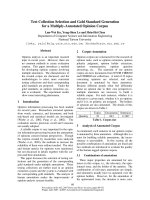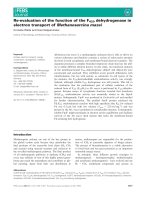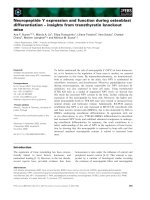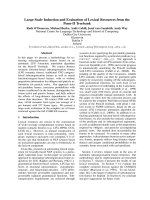Báo cáo khoa học: "Premortem clinical diagnoses and postmortem autopsy findings: discrepancies in critically ill cancer patients" potx
Bạn đang xem bản rút gọn của tài liệu. Xem và tải ngay bản đầy đủ của tài liệu tại đây (113.95 KB, 6 trang )
Open Access
Available online />Page 1 of 6
(page number not for citation purposes)
Vol 11 No 2
Research
Premortem clinical diagnoses and postmortem autopsy findings:
discrepancies in critically ill cancer patients
Stephen M Pastores, Alina Dulu, Louis Voigt, Nina Raoof, Margarita Alicea and Neil A Halpern
Critical Care Medicine Service, Department of Anesthesiology and Critical Care Medicine, Memorial Sloan-Kettering Cancer Center, 1275 York
Avenue, New York, NY 10021, USA
Corresponding author: Stephen M Pastores,
Received: 5 Feb 2007 Revisions requested: 9 Feb 2007 Revisions received: 20 Mar 2007 Accepted: 20 Apr 2007 Published: 20 Apr 2007
Critical Care 2007, 11:R48 (doi:10.1186/cc5782)
This article is online at: />© 2007 Pastores et al.; licensee BioMed Central Ltd.
This is an open access article distributed under the terms of the Creative Commons Attribution License ( />),
which permits unrestricted use, distribution, and reproduction in any medium, provided the original work is properly cited.
Abstract
Introduction Limited data are available regarding the
relationship of premortem clinical diagnoses and postmortem
autopsy findings in cancer patients who die in an oncologic
intensive care unit (ICU). The purposes of this study were to
compare the premortem clinical and postmortem diagnoses of
cancer patients who died in the ICU and to analyze any
discrepancies between them.
Methods This is a retrospective review of medical records and
autopsy reports of all cancer patients who died in a medical-
surgical ICU and had an autopsy performed between 1 January
1999 and 30 September 2005 at a tertiary care cancer center.
Premortem clinical diagnoses were compared with the
postmortem findings. Major missed diagnoses were identified
and classified, according to the Goldman criteria, into class I
and class II discrepancies.
Results Of 658 deaths in the ICU during the study period, 86
(13%) autopsies were performed. Of the 86 patients, 22 (26%)
had 25 major missed diagnoses, 12 (54%) patients had class I
discrepancies, 7 (32%) had class II discrepancies, and 3 (14%)
had both class I and class II discrepancies. Class I
discrepancies were due to opportunistic infections (67%) and
cardiac complications (33%), whereas class II discrepancies
were due to cardiopulmonary complications (70%) and
opportunistic infections (30%).
Conclusion There was a discrepancy rate of 26% between
premortem clinical diagnoses and postmortem findings in
cancer patients who died in a medical-surgical ICU at a tertiary
care cancer center. Our findings underscore the need for
enhanced surveillance, monitoring, and treatment of infections
and cardiopulmonary disorders in critically ill cancer patients.
Introduction
Major discrepancy rates between premortem clinical diag-
noses and postmortem autopsy findings continue to be
reported in critically ill patients admitted to the intensive care
unit (ICU) [1-22]. However, there are limited data regarding
the relationship of premortem diagnoses and postmortem find-
ings specifically in cancer patients who die in an oncologic
ICU [23,24]. The purposes of this study were to compare the
premortem clinical and postmortem diagnoses of cancer
patients who died in the ICU and to analyze any discrepancies
between them.
Materials and methods
This is a retrospective study of all patients who died in the ICU
and had an autopsy performed between 1 January 1999 and
30 September 2005 at Memorial Sloan-Kettering Cancer
Center, a 435-bed tertiary care cancer center in New York
City. The ICU is a 'closed' 12-bed adult medical-surgical unit
staffed by anesthesiology and internal medicine housestaff,
critical care fellows, and full-time critical care medicine attend-
ing physicians. The ICU attending physicians conduct multi-
disciplinary rounds twice daily and supervise and approve all
clinical decisions in collaboration with the admitting medical
and surgical teams. Our standard of care includes surveillance
for nosocomial infections, aggressive and early use of broad-
spectrum antimicrobial agents in patients with suspected or
proven infection, and routine use of antimicrobial-impregnated
central venous catheters.
Consent for an autopsy is always requested from the health
care proxy and/or a relative of the deceased patient by the ICU
housestaff or attending physician and occasionally by the
HSCT = hematopoietic stem cell transplantation; ICU = intensive care unit; LOS = length of stay.
Critical Care Vol 11 No 2 Pastores et al.
Page 2 of 6
(page number not for citation purposes)
primary admitting team. Autopsies commonly are performed
within 24 hours of death. The standard autopsy includes gross
and histopathologic examination of all internal organs and the
brain, when indicated.
All ICU admissions, deaths, and autopsies were identified by
the hospital's institutional database. The following data were
obtained from the electronic medical record for the ICU
patients who died in the ICU and had autopsies: age, gender,
admitting service (medical or surgical), underlying cancer
diagnoses, and lengths of ICU stay and hospital stay. The
major premortem clinical diagnoses and causes of death,
including the immediate cause of death and the underlying pri-
mary disease, were recorded. The autopsy diagnoses were
obtained from the final autopsy reports. Based on a review of
the medical record and the autopsy diagnoses, two investiga-
tors (AD and LV) independently identified the clinical causes
of death and then compared their results. If there was disa-
greement, the medical records were reviewed together by
both investigators and a consensus on the cause of death was
reached after discussion.
Discrepancies between premortem clinical and autopsy diag-
noses were classified using the Goldman criteria (Table 1)
[25]. For the purposes of this study, we focused only on the
class I and class II major discrepancies [2]. Class I discrepan-
cies were defined as a missed major diagnosis that, had it
been made, would have changed management and might have
resulted in prolonged survival. Class II discrepancies were a
missed major diagnosis with no impact on treatment and sur-
vival because either the patient was already receiving appro-
priate therapy even though the diagnosis was not known or
effective therapy was not available at the time.
Patients were categorized into three groups: (a) patients in
whom a major clinical diagnosis was missed premortem (dis-
cordant cases), (b) patients in whom the premortem clinical
diagnosis was confirmed on autopsy (concordant cases), and
(c) patients in whom no pathologic diagnosis could be con-
firmed on autopsy.
Statistical analysis
Data are presented as means ± standard deviations, absolute
numbers, or percentages. Statistical analyses used included
Fisher exact test and one-way analysis of variance to test for
differences among the three groups. P values of less than 0.05
were considered significant. All statistical analyses were per-
formed using statistical software (SPSS 12.0; SPSS Inc., Chi-
cago, IL, USA). The study was approved by the institutional
review board, which waived the need for informed consent.
Results
Between 1 January 1999 and 30 September 2005, 658
(20.2%) of the 3,257 patients admitted to the ICU died. Of the
658 deaths, 86 (13%) had an autopsy. During the study
period, our autopsy rates averaged 13% per year (range, 7.7%
to 21.2% per year).
Of the 86 patients who underwent an autopsy, 38 (44%) were
women and 48 (56%) were men. The mean age was 54 ± 16
years. The mean length of stay (LOS) in the ICU was 9 ± 8
days, and the mean LOS in the hospital was 19 ± 18 days.
Twenty-four patients (28%) were surgical patients and 62
(72%) were medical. Of the 24 surgical patients, 10 (42%)
underwent thoracotomy for lung or esophageal cancer, 10
(42%) gastrointestinal/hepatobiliary surgery for hepatic or
pancreatic cancer, 2 (8%) orthopedic surgery for sarcoma, 1
head and neck cancer surgery, and 1 gynecologic cancer sur-
gery. Of the 62 medical patients, 25 (40%) had undergone
hematopoietic stem cell transplantation (HSCT), 18 (29%)
had hematologic malignancies (leukemias or lymphomas), and
19 (31%) had solid tumors.
Major missed diagnoses (discordant cases) were noted in 22
patients (26%) (group 1): 12 (54%) patients had class I dis-
crepancies, 7 (32%) had class II discrepancies, and 3 (14%)
had both class I and class II discrepancies. Among the 22 dis-
cordant cases, 6 had undergone surgery, 6 had hematologic
malignancies, 6 had solid tumors, and 4 underwent HSCT.
Opportunistic infections were the most common class I dis-
crepancies, followed by cardiac complications (thrombotic
endocarditis, myocardial infarction, and heart failure) (Table 2).
The opportunistic infections were due to one of several path-
ogens (viral, fungal, bacterial, and parasitic). The lung was the
most commonly infected site, with pneumonia and empyema
Table 1
Goldman criteria for autopsy discrepancies [25]
Major discrepancies Class I Missed major diagnosis with potential adverse impact on survival and that would have changed management
Class II Missed major diagnosis with no potential impact on survival and that would have not changed therapy
Minor discrepancies Class III Missed minor diagnosis related to terminal disease but not related to the cause of death
Class IV Other missed minor diagnosis
Available online />Page 3 of 6
(page number not for citation purposes)
present in seven patients, followed by central nervous system
infections (two patients), gastrointestinal infections (two
patients), and widely disseminated disease (two patients). The
majority of class II discrepancies were accounted for by cardi-
opulmonary complications (n = 7) attributed to pulmonary
emboli and thrombotic endocarditis (Table 2).
Clinical diagnoses were confirmed by autopsy in 49 patients
(57%) (group 2). Most of the confirmed diagnoses were due
to bacterial or fungal infections. Autopsy was inconclusive in
15 patients (17%) (group 3). Of the 15 patients, 12 (80%)
were medical patients and 3 (20%) were surgical. The majority
of group 3 patients died of multiple organ failure and systemic
inflammatory response of unknown etiology, and no specific
cause of death could be discerned on autopsy. The autopsies
of these patients showed diffuse alveolar damage in the lung
and diffuse non-specific inflammatory response with scaring
and fibrosis in other organs, and positive cultures were not
obtained.
There were no statistically significant differences in age or
gender between the patients who had missed major diag-
noses (group 1) and those with autopsy confirmation of pre-
mortem clinical diagnoses (group 2) (Table 3). However, the
patients with no pathologic diagnosis made on autopsy (group
3) had a significantly longer ICU LOS compared to those with
autopsy confirmation of premortem clinical diagnoses (p =
0.05). Overall, patients with autopsy confirmation of premor-
tem clinical diagnoses were not significantly different from
those with missed diagnoses (p = 0.11).
Discussion
In this study, we found an overall discrepancy rate of 26%
between the premortem clinical and autopsy diagnoses in can-
cer patients who died in a medical-surgical ICU at a tertiary
cancer center. Our discrepancy rate of 26% is within the
range of discrepancy rates (5% to 32%) that have been
reported for autopsies performed in the general adult ICU
population [1-22]. To our knowledge, however, only two previ-
Table 2
Class I and class II discrepancies
N
Opportunistic VRE pneumonia 2
infections Legionella pneumonia 1
(n = 10) PCP pneumonia 1
Invasive aspergillosis 1
Candida empyema 1
Class I VZV meningoencephalitis 1
discrepancies HSV esophagitis 1
(n = 15) CMV pneumonia 1
Disseminated necrotizing toxoplasmosis 1
Cardiac Ischemic cardiomyopathy 2
complications Thrombotic endocarditis 2
(n = 5)
Congestive heart failure 1
Cardiopulmonary Pulmonary embolism 4
Class II complications
discrepancies (n = 7) Thrombotic endocarditis 2
(n = 10) Pulmonary hemorrhage 1
Opportunistic Candidemia 1
infections (n = 3) VRE meningitis 1
CMV proctitis 1
CMV, cytomegalovirus; HSV, herpes simplex virus; PCP, pneumocystis carinii pneumonia; VRE, vancomycin-resistant enterococcus; VZV,
varicella-zoster virus.
Critical Care Vol 11 No 2 Pastores et al.
Page 4 of 6
(page number not for citation purposes)
ous autopsy studies have examined diagnostic discrepancy
rates in cancer patients who died in the ICU [23,24]. Gerain
and colleagues [23] reported a 59% major discrepancy rate in
a medical oncologic ICU population. Unlike in our findings, the
majority of major discrepancies were due to complications of
the cancer itself or its treatment (for example, non-cardiogenic
pulmonary edema, acute hemorrhage, and pulmonary embo-
lism) rather than infection. We ascribe the marked difference
in the discrepancy rates between the study by Gerain and col-
leagues [23] and our study (59% versus 26%) to the type of
cancer patient population studied (medical versus mixed med-
ical-surgical) and to improved diagnostic techniques and ther-
apeutic strategies in recent years. However, when we
compare our findings in a select patient population (the HSCT
subgroup) to a similar HSCT population study [24], we
observed an almost comparable, low discrepancy rate (16%
versus 7%).
Opportunistic infections accounted for the majority (67%) of
class I discrepancies. In contrast to previous studies that
showed a predominance of fungal infections in immunocom-
promised patients [1,23], the opportunistic infections in our
study were represented by various pathogens (viral, fungal,
and parasitic) (Table 2). We ascribe these findings to the
increasing exposure of our patients to broad-spectrum antimi-
crobials that effect the terminal flora and promote the emer-
gence of more virulent and resistant nosocomial infections
[26,27]. Our findings reinforce the difficulty of diagnosing dif-
ferent infectious entities such as nosocomial pneumonia and
fungal and viral infections in critically ill patients [23,24]. We
suggest that novel microbiologic identification with non-cul-
ture techniques, including serologic tests, immunohistologic
methods, polymerase chain reaction, and molecular-probing
technologies, be introduced to aid in the rapid diagnosis of
these virulent infections [28,29].
In this study, we describe a category of patients (group 3, n =
15) who experienced prolonged ICU and hospital LOSs and
had uncertain premortem diagnoses, and their autopsies were
inconclusive, showing only non-specific, chronic inflammatory,
and fibrotic changes in various organs, including the lung, kid-
ney, and liver. These findings are not unexpected as it is well
known that autopsies of patients who die after a prolonged
period of resuscitation and support in the ICU typically report
multiple organ failure as the primary cause of death regardless
of the different primary diagnoses [30]. Thus, in our opinion,
postmortem information may be similarly limited in providing a
specific diagnosis of the cause of death in cancer patients
who die after a prolonged ICU and hospital LOS (Table 3).
The 13% average yearly autopsy rate in our study is much
lower than that of other published postmortem studies from
adult ICUs [1-6,8,11-17]. We ascribe our lower ICU autopsy
rate to one of three possibilities. First, in our center, the physi-
cian caring for the patient during hospitalization may differ from
the outpatient physician who has a long-standing rapport with
the family. Additionally, when the patient is admitted to the
ICU, the critical care team assumes primary care. Thus, there
may not be a single physician with a close enough relationship
to the patient's next of kin at the time of death to obtain con-
sent for an autopsy. Second, due to the frequent use of
advanced high-tech investigative modalities available at our
center, both physicians and family members may perceive that
the autopsy will have a low yield. Third, when patients with
advanced cancer die, physicians and family members often
attribute the death to the expected complications of the malig-
nancy. In this circumstance, it is perceived that an autopsy is
unnecessary.
Our study has several limitations, including the retrospective
study design and selection bias that may have occurred; phy-
sicians and family members of patients with premortem diag-
nostic uncertainty would have been more likely to pursue an
autopsy than in cases in which all parties were certain of the
diagnoses and the outcome was predictable. Similar to prior
studies [13,15], we were unable to fully account for all the pre-
mortem diagnostic investigations that were performed on all
the autopsied patients. Nevertheless, we believe that our find-
ings may be extrapolated to similar critically ill cancer patients
treated in general ICUs.
Conclusion
Our study suggests that missed major diagnoses with poten-
tial impact on treatment and survival were noted in 26% of crit-
ically ill cancer patients admitted to an oncologic ICU. The
missed major diagnoses were commonly due to opportunistic
Table 3
Characteristics of critically ill cancer patients who underwent autopsy
Missed major diagnosis
(n = 22)
Clinical diagnosis confirmed
(n = 49)
No pathologic diagnosis made
(n = 15)
P value
Gender (males/females) 12:10 29:20 7:8 0.688
Age (years) 59 ± 12 55 ± 15 50 ± 19 0.223
ICU LOS (days) 7.5 ± 7 8 ± 10 15 ± 14 0.039
Hospital LOS (days) 15 ± 13 18 ± 16 29 ± 26 0.054
Data are presented as means ± standard deviations, absolute numbers, or percentages. ICU, intensive care unit; LOS, length of stay.
Available online />Page 5 of 6
(page number not for citation purposes)
infections and cardiac complications. Our findings underscore
the need for enhanced premorbid surveillance, monitoring,
and treatment of infections and cardiopulmonary disorders in
critically ill cancer patients. However, given the limitations of
present-day microbiologic evaluation and treatment and car-
diac imaging at the ICU bedside, the autopsy remains an inval-
uable tool for retrospective diagnostic understanding of
difficult cases, medical education, and quality assurance.
Competing interests
The authors declare that they have no competing interests.
Authors' contributions
SMP, AD, and LV were responsible for the study design and
data analysis. All authors were involved in drafting the manu-
script and have full access to the data and take full responsi-
bility for its integrity. All authors read and approved the final
manuscript.
Acknowledgements
We thank Hao Zhang, research assistant, Department of Anesthesiol-
ogy and Critical Care Medicine, and Elyn Riedel, biostatistician, Depart-
ment of Epidemiology and Biostatistics, for assistance with the data
analysis.
References
1. Nadrous HF, Afessa B, Pfeifer EA, Peters SG: The role of
autopsy in the intensive care unit. Mayo Clin Proc 2003,
78:947-950.
2. Combes A, Mokhtari M, Couvelard A, Trouillet JL, Baudot J, Henin
D, Gibert C, Chastre J: Clinical and autopsy diagnoses in the
intensive care unit: a prospective study. Arch Intern Med 2004,
164:389-392.
3. Roosen J, Frans E, Wilmer A, Knockaert DC, Bobbaers H: Com-
parison of premortem clinical diagnoses in critically ill patients
and subsequent autopsy findings. Mayo Clin Proc 2000,
75:562-567.
4. Blosser SA, Zimmerman HE, Stauffer JL: Do autopsies of criti-
cally ill patients reveal important findings that were clinically
undetected? Crit Care Med 1998, 26:1332-1336.
5. Fernandez-Segoviano P, Lazaro A, Esteban A, Rubio JM, Iruretago-
yena JR: Autopsy as quality assurance in the intensive care
unit. Crit Care Med 1988, 16:683-685.
6. Gut AL, Ferreira ALA, Montenegro MR: Autopsy: quality assur-
ance in the ICU. Intensive Care Med 1999, 25:360-363.
7. Barendregt WB, de Boer HHM, Kubat K: Quality control in fatally
injured patients: the value of the necropsy. Eur J Surg 1993,
159:9-13.
8. Mort T, Yeston N: The relationship of pre mortem diagnoses
and post mortem findings in a surgical intensive care unit. Crit
Care Med 1999, 27:299-303.
9. Berlot G, Dezzoni R, Viviani M, Silvestri L, Bussani R, Gullo A:
Does the length of stay in the intensive care unit influence the
diagnostic accuracy? A clinical-pathological study. Eur J
Emerg Med 1999, 6:227-231.
10. Sharma BR, Gupta M, Harish D, Singh VP: Missed diagnoses in
trauma patients vis-à-vis significance of autopsy. Injury 2005,
36:976-983.
11. Tai DY, El-Bilbeisi H, Tewari S, Mascha EJ, Wiedemann HP, Arro-
liga AC: A study of consecutive autopsies in a medical ICU: a
comparison of clinical cause of death and autopsy diagnosis.
Chest 2001, 119:530-536.
12. Twigg SJ, McCrirrick A, Sanderson PM: A comparison of post-
mortem findings with post hoc estimated clinical diagnoses of
patients who die in a United Kingdom intensive care unit.
Intensive Care Med 2001, 27:706-710.
13. Silfvast T, Takkunen O, Kolho E, Andersson LC, Rosenberg P:
Characteristics of discrepancies between clinical and autopsy
diagnoses in the intensive care unit: a 5-year review. Intensive
Care Med 2003, 29:321-324.
14. Ong AW, Cohn SM, Cohn KA, Jaramillo DH, Parbhu R, McKenney
MG, Barquist ES, Bell MD: Unexpected findings in trauma
patients dying in the intensive care unit: results of 153 consec-
utive autopsies. J Am Coll Surg 2002, 194:401-406.
15. Perkins GD, McAuley DF, Davies S, Gao F: Discrepancies
between clinical and postmortem diagnoses in critically ill
patients: an observational study. Crit Care 2003, 7:R129-132.
16. Dimopoulos G, Piagnerelli M, Berre J, Salmon I, Vincent JL: Post-
mortem examination in the intensive care unit: still useful?
Intensive Care Med 2004, 30:2080-2085.
17. Magret-Iglesias M, Vidaur Tello L, Fernandez Olsina S, Garcia
Fontgivell JF, Blazquez Vilas S, Alonso Rubio S, Diaz Santos E, Sir-
vent Calvera JJ, Rello J: Discrepancies between clinical and
pathological diagnosis in a polyvalent intensive care service.
Med Intensiva 2006, 30:95-100.
18. Combes A, Luyt CE, Trouillet JL, Chastre J: Is there still a role for
autopsies in the intensive care unit? Clin Pulm Med 2006,
13:188-193.
19. Pastores SM, Halpern NA: Autopsies in the ICU: we still need
them! Crit Care Med 1999, 27:235-236.
20. Podbregar M, Voga G, Krivec B, Skale R, Pareznik R, Gabrscek L:
Should we confirm our clinical diagnostic certainty by
autopsies? Intensive Care Med 2001, 27:1750-1755.
21. Shojania KG, Burton EC, McDonald KM, Goldman L: Changes in
rates of autopsy-detected diagnostic errors over time: a sys-
tematic review. JAMA 2003, 289:2849-2856.
22. Maris C, Martin B, Creteur J, Remmelink M, Piagnerelli M, Salmon
I, Vincent JL, Demetter P: Comparison of clinical and post-mor-
tem findings in intensive care unit patients. Virchows Arch
2007, 450:
329-333.
23. Gerain J, Sculier JP, Malengreaux A, Rykaert C, Themelin L:
Causes of deaths in an oncologic intensive care unit: a clinical
and pathological study of 34 autopsies. Eur J Cancer 1990,
26:377-381.
24. Al-Saidi F, Diaz-Granados N, Messner H, Herridge MS: Relation-
ship between premortem and postmortem diagnoses in criti-
cally ill bone marrow transplantation patients. Crit Care Med
2002, 30:570-573.
25. Goldman L, Sayson R, Robbins S, Cohn LH, Bettmann M, Weis-
berg M: The value of the autopsy in three medical eras. N Engl
J Med 1983, 308:1000-1005.
26. Crnich CJ, Safdar N, Maki DG: The role of the intensive care unit
environment in the pathogenesis and prevention of ventilator-
associated pneumonia. Respir Care 2005, 50:813-836.
27. Safdar N, Maki DG: The commonality of risk factors for noso-
comial colonization and infection with antimicrobial-resistant
Staphylococcus aureus, enterococcus, gram-negative bacilli,
Clostridium difficile, and Candida. Ann Intern Med 2002,
136:834-844.
28. Pryce TM, Palladino S, Price DM, Gardam DJ, Campbell PB, Chris-
tiansen KJ, Murray RJ: Rapid identification of fungal pathogens
in BacT/ALERT, BACTEC, and BBL MGIT media using
polymerase chain reaction and DNA sequencing of the internal
transcribed spacer regions. Diagn Microbiol Infect Dis 2006,
54:289-297.
29. Buchheidt D, Hummel M, Schleiermacher D, Spiess B, Hehlmann
R: Current molecular diagnostic approaches to systemic infec-
Key messages
• Missed major diagnoses with potential impact on treat-
ment and survival were noted in 26% of cancer patients
admitted to an oncologic ICU.
• Opportunistic infections and cardiac complications
were the most commonly missed major diagnoses.
• Our findings underscore the need for enhanced surveil-
lance, monitoring, and treatment of infections and cardi-
opulmonary disorders in critically ill cancer patients.
Critical Care Vol 11 No 2 Pastores et al.
Page 6 of 6
(page number not for citation purposes)
tions with aspergillus species in patients with hematological
malignancies. Leuk Lymphoma 2004, 45:463-468.
30. Baue AE: Multiple, progressive, or sequential systems failure:
a syndrome of the 1970s. Arch Surg 1975, 110:779-781.









